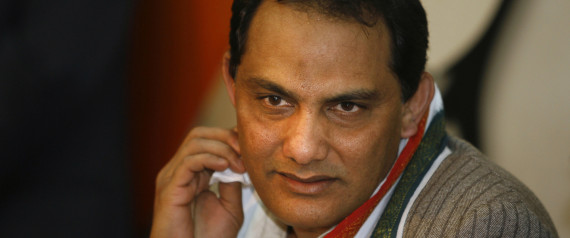Now, the simple answer is of course, that Azhar was on Sony's SET Max channel to spark interest in the then yet-to-be-released film
Azhar on his rise, fall, and supposed "redemption", which just happens to be produced by Sony Pictures.
[H]ow did he manage to redeem himself among large sections of the public, enough for him to be elected to Parliament as Congress MP from Moradabad...?
However, what followed was a barrage of abuse (and atrocious spelling) directed at Nannes from Azharuddin's fans on Twitter, giving us a glimpse into the more complex answer to Nannes' question:
The answer is that many people today, having been too young to remember the details of the 2000 match-fixing scandal and subsequent CBI investigation, are under the impression that Azharuddin was an innocent victim of circumstances, whose name was cleared of suspicion by an Andhra Pradesh High Court judgement (even though the judgement was on the technicalities of his ban, not his actual innocence or guilt in match-fixing).
From match-fixing to image-fixing
Despite Azhar's video-taped confessions to the CBI back in 2000, enumerating specific matches he fixed, as well as his links to Anees and Dawood Ibrahim, Tiger Memon, and Abu Salem, how did he manage to redeem himself among large sections of the public, enough for him to be elected to Parliament as Congress MP from Moradabad with little challenge from the media, cricket community or our famously cricket-obsessed public?
Despite the
full text of the CBI report being available online since 2000, how did he manage to shape the public discourse on his misdeeds by challenging his lifetime ban on a mere technicality, and then hailing a 2012 Andhra Pradesh High Court judgement of the ban as being "unsustainable" as a great vindication and certificate of innocence?
[I]f [young Indians] want to hear the real story, rather than this dubious "biopic", there's no better source than revisiting Azhar's own words.
After the initial flurry of investigative journalism leading up to and following the match-fixing scandal of the early 2000s, for the last 10 years, the silence of a pliant media, BCCI and cricketing community in this country allowed Azhar to do all the talking, and shape public opinion of himself with little to no challenge. And unlike before, when the in-depth analysis on Azhar's confessions to the CBI were only available in the print media or nascent Indian internet, the "improved" version of his story that he has pushed in recent years has reached a much wider audience, thanks to increasing social media penetration and rent-a-mob Twitter and Facebook fans.
Now, before this film becomes the pinnacle of his attempt to rewrite the story and definitively imprint upon the public that the courts cleared him of all match-fixing charges, it is important for the media to ensure that the truth from 16 years ago is dusted off from newspaper and magazine archives and brought back into the public's eye. Dirk Nannes deserves credit and respect for sticking to his guns and not getting bullied by the trolls, and responding to their ignorance by presenting news articles and the even the full CBI report detailing Azhar's confessions.
Azhar broke down after the CBI showed him evidence of his extensive links with the Indian underworld [including] photographs...with Yakub and Tiger Memon.
Sadly, since our own media failed to do so for the last decade, this was a case of too little, too late, as a large section of the public has already swallowed Azhar's whitewashed version, and risen to his defence. One could not help but see the similarity with Salman Khan's brush-ins with the law and the internet army he has amassed in recent years, replete with the crude insults and unfamiliarity with grammar. Still, although Nannes's efforts were the equivalent of casting pearls before swine, the point was made - the new, internet-savvy generation of India needs to hear the truth about Azhar, and if they want to hear the real story, rather than this dubious "biopic", there's no better source than revisiting Azhar's own words.
'Haan, maine match banaaya tha'
For those of us who closely followed the investigations into the 2000 match-fixing scandal, this poetic excerpt from
India Today's in-depth coverage at the time remains the defining moment of Azhar's fall from grace:
"Even for a government babu's office, it was a long, uncomfortable moment. There they sat, 10 interrogators all cramped into one room, taking notes, cross referencing their memories and shuffling through papers.
With them sat a man who was slowly, in front of their eyes, collapsing into himself. He wore a green and yellow T-shirt that screamed sunshine but chose to cover his eyes with dark glasses. His hands, the ones they called among the safest in the world, were locked into one another but his life's work, his very life, was slipping through those fingers.
Mohammed Azharuddin, former India captain and darling of millions, found himself in front of the officers of the Central Bureau of Investigation (CBI) and a mountain of evidence, and could only say, 'Haan, maine match banaaya tha(Yes, I had fixed the match).'"
Rakesh Maria [said] Azhar was the "kingpin" of match-fixing, with "a criminal bent of mind"... and considered a "Bhai" by Anees Ibrahim, Chhota Shakeel, and Sharad Shetty.
According to sources at the time, after initially denying all accusations of match-fixing, Azhar broke down after the CBI showed him evidence of his extensive links with the Indian underworld, led by Mumbai Police Commissioner M.N. Singh's damning evidence -- back in 1993,
photographs of Azhar with Yakub and Tiger Memon (Dawood's lieutenant and the main accused in the 1993 Bombay serial bomb blasts case) surfaced during investigations led by the high-profile supercop and former Mumbai Police Commissioner Rakesh Maria. In the photos, Azhar was in the Memons' home -- in one, Azhar in white trousers and black spotted shirt is sitting with Tiger and Yakub in their bedroom; in the other, he's posing with Tiger.
Rakesh Maria also featured on camera in the famous
Tehelka match-fixing investigation, in conversation with Aniruddha Bahal, saying he knew since the mid-1990s, well before the CBI investigations, that Azhar was the
"kingpin" of match-fixing in India, with "a criminal bent of mind", and was considered a "Bhai" by
Anees Ibrahim, Chhota Shakeel, and Sharad Shetty.
In addition, Directorate of Revenue Intelligence (DRI) men conducting routine surveillance in November 1997,
stumbled upon a conversation between Azhar and Anees Ibrahim, brother of Dawood, on the latter's personal mobile phone (00971 444 8585).
The conversation revolved around the fixing of a Titan Cup match between India and South Africa.
[H]e admitted to his relationship with underworld don Abu Salem, his attempts at match-fixing and betting with teammates Ajay Sharma, Ajay Jadeja and Nayan Mongia, as well as bookies...
Plus, mere weeks before the match-fixing scandal was exposed, a Mumbai businessman named Ashraf Patel was gunned down outside his home, just two days after being seen with Azhar. When questioned by the CBI, Azhar claimed Patel had no "involvement with cricket", but the Mumbai Police suspected otherwise, with an officer
saying, "Patel was gunned down because he knew too much about betting deals and match-fixing involving some prominent cricketers and influential persons in Mumbai. He could have been silenced to destroy evidence."
The Mumbai Police continued, with evidence that it was
Ashraf Patel who first introduced Azhar to Dawood's lieutenant Sharad Shetty -- a man known to be in control of betting in horse-racing-- in Sharjah in 1997. So close were their links, claimed the police, that
Azhar lived in his Dubai apartment when he was in the Emirates and accepted expensive gifts from him.
Azhar tried to redeem himself by telling CBI investigators that underworld don Abu Salem had also approached him to fix matches, but he had refused. But this only corroborated the testimony of the Indian cricket team's physiotherapist Ali Irani, who told the CBI,
"Azhar had once said that since he was doing matches with Anees Ibrahim (the brother of Dawood Ibrahim), he would not do [sic] with anyone else."As he broke down under this extensive evidence, Azhar
confessed to fixing three specific matches:
•
India vs. South Africa at Rajkot at the 1996 Titan Cup (
Scorecard) for bookie Mukesh Gupta (the match discussed with Anees Ibrahim).
•
India vs. Sri Lanka at Colombo at the 1997 Asia Cup (
Scorecard) for bookie Mukesh Gupta.
•
India vs. Pakistan at Jaipur in 1999 (
Scorecard) for bookie Ajay Gupta (no relation to Mukesh).
I appeal to all the public to not be swayed by the misinformation Azhar is spreading about himself in the media...
Strengthened by testimony from Sachin Tendulkar, where he told the CBI of his suspicions of Azhar's links with bookies, the investigators were convinced that these three matches were merely the tip of the iceberg,
reporting, "In view of the large amount of money Azhar had received from Ajay Gupta and the hospitality he has enjoyed through him it is very difficult to believe that he did only one match for them."
If this weren't enough, in April 2005,
Outlook magazine made a startling discovery. In July 2000, the Income Tax Department raided a number of cricketers and celebrities across India, in collaboration with the CBI's investigation. During their raids, they found a fax between Azharuddin and his second wife Sangeeta Bijlani, consisting of multiple pages of Azhar's handwritten notes -- a record of what transpired during his CBI interrogations. In these notes, he admitted to his relationship with underworld don Abu Salem, his attempts at match-fixing and betting with teammates Ajay Sharma, Ajay Jadeja and Nayan Mongia, as well as bookies including the famous Mukesh K. Gupta, who was named by Hansie Cronje in the first of the series of events that led to the implication of Azharuddin himself.
In his notes, Azhar even details how he lied to CBI investigators when asked about his links to Abu Salem, only to be caught out in a way that would remind many a fan of the way Azhar threw his wicket away in fixed matches:
"I said no, then they said that during the Chandigarh match in 1996 you spoke to [Abu Salem], I said I don't know and have not spoken to him. They said he offered you 1.25 cr to fix a match. I said no. I kept lying to them all the time. In the end they played the tapes of him talking to me. It was very embarrassing."
The notes end on a very interesting note, of interest to us today in the light of how much he has succeeded in fixing his image:
"Why everybody is targeting me? [sic] Mainly because I am from minority community. I am being victimised and targeted ... specially some ex-cricketers raising fingers against me to settle their personal grudges and they can't stand the idea that a person from the minority community should be in the saddle of Indian Cricket specially when I have remained there for 16 years.
I appeal to all the public not to be swayed away by the misinformation about me spread by the media, vilification campaign carried out against me in order to dislodge me and to create dispathy [sic] in the minds of the public."
Let's not be fooled
Which brings us to today, the day that the tables are turned, and with the release of his film, it is Azhar who has reached the high-point of his own attempt at doing the very same that he accused others of. So, to appropriate the words of the man himself:
I appeal to all the public to not be swayed by the misinformation Azhar is spreading about himself in the media, and this rehabilitation campaign carried to restore his tainted reputation to respectability and to create sympathy in the minds of the public.
http://www.huffingtonpost.in/ruchir-ferrero-sharma/sorry-bollywood-the-truth_b_10001876.html












